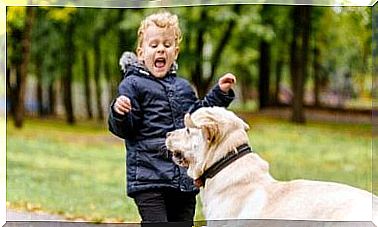Hypothermia In Children: What Can You Do?

Hypothermia in children occurs when their body temperature falls below the limits considered normal, that is, below 35 degrees Celsius. Below that limit, the body’s heat regulation will fail.
Hypothermia usually results from prolonged exposure to cold temperatures without adequate protection. In this article you will learn what to do if you need to treat a case of hypothermia in young children.
Hypothermia in children and babies: what you need to know
First of all, it is important to know that there are many different ways in which the body can lose heat. These include:
- radiation. There is a difference in the temperature gradient between the body and its environment.
- Conduction. This occurs through contact with surfaces of a certain temperature. Hypothermia refers to contact with cold or low temperatures.
- Evaporation. This results from the loss of heat through the conversion of a body fluid into steam or gas. For example, more sweat and rapid breathing.
Causes of Hypothermia in Children
Hypothermia can occur in any group of the population and in any season of the year. Babies and young children are most affected because their bodies are still developing. Thus, the mechanisms to regulate temperature are not yet fully developed.
The most common causes of hypothermia in children and babies include:
- insufficient protection against low temperatures
- letting the baby or child wear wet clothes for too long in a cold environment or during the cold wind
- exposure to cold temperatures (cold compresses, cold water baths, ventilators) to lower a fever, which can even lead to shock from such a sudden change in temperature
Hypothermia in children
Hypothermia in children can be the result of insufficient protection against low temperatures. That is why it is important to be aware of the symptoms.
The Symptoms of Hypothermia
- Children and babies shiver or get shivers.
- Also, their skin may become cold and/or pale, but in the case of many babies, the skin remains pink.
- Their breathing and heart rate slow down.
- The reflexes no longer respond well.
You should pay special attention to a baby’s skin temperature, behavioral changes and lack of appetite because they can’t tell they are cold.
How do you deal with hypothermia in a baby?
You should contact a doctor right away at the first sign of hypothermia in your baby. If you can’t get medical help right away, do the following while on the road or waiting:
- Gradually increase the heat of their environment and transfer them to a heated room.
- Remove any wet clothes they may be wearing.
- Cover and protect their heads with a hat or blanket and hug them against your chest so they warm up to your body heat.
- You should not apply a direct heat source to bare skin. Also, don’t use a hot water bottle or compresses unless there’s a cloth around them, otherwise it could lead to burns.
- Check the child’s vital signs occasionally, even after you’ve stabilized the hypothermia. Also check their breathing if they lose consciousness. If you must use mouth-to-mouth resuscitation, place the child in a recovery position. Then do the mouth-to-mouth resuscitation and continue with a chest compressions while you wait for medical attention.
If you have a case of hypothermia in a baby, it is important to warm him or her up gradually. If the symptoms worsen or are clearly severe, you should do whatever you see fit to get the baby to a doctor or emergency room as soon as possible.
How do you deal with hypothermia in children?
Depending on the seriousness of the situation, you may have to make an emergency call. To do this, call 112. Evaluate the symptoms. If you don’t notice any serious signs of hypothermia, continue with the following steps:
- Place the child in a bath full of warm (not hot) water until you see that the skin color has returned to normal. Then help the child and dry it quickly.
- Then dress it in warm, dry clothes, take it to a warm room, and wrap it in as many blankets as needed. Just like with babies, you can hug the child to warm up with your body heat. Also cover the head with a hat, as well as their hands and feet.
- In addition, give them a hot drink and energy-rich food.
- Do not leave them alone at any time, as the symptoms could worsen.
In general, the body temperature will return to normal in a relatively short period of time after applying these techniques. If not and the child’s condition worsens, call 911 immediately.









